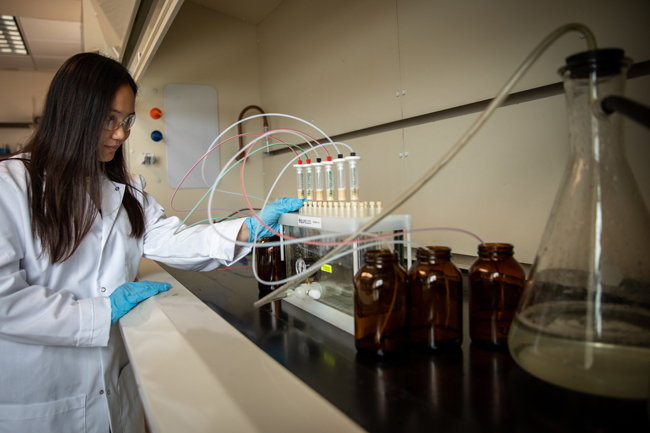
UB chemistry PhD candidate Luisa Angeles in the lab. Credit: Meredith Forrest Kulwick
— By Charlotte Hsu, UBNow, News and views for UB faculty and staff
Buffalo, NY, Jaunary 9, 2020 - A study of seven wastewater treatment plants in the Eastern United States reveals a mixed record when it comes to removing medicines such as antibiotics and antidepressants.
The research points to two treatment methods — granular activated carbon and ozonation — as being particularly promising. Each technique reduced the concentration of a number of pharmaceuticals, including certain antidepressants and antibiotics, in water by more than 95%, the scientists’ analysis found.
Activated sludge, a common treatment process that uses microorganisms to break down organic contaminants, serves an important purpose in wastewater treatment but was much less effective at destroying persistent drugs such as antidepressants and antibiotics.
“The take-home message here is that we could actually remove most of the pharmaceuticals we studied. That’s the good news. If you really want clean water, there are multiple ways to do it,” says Diana Aga, Henry M. Woodburn Professor of Chemistry, College of Arts and Sciences.
“However, for plants that rely on activated sludge only, more advanced treatment like granular activated carbon and/or ozonation may be needed,” Aga adds. “Some cities are already doing this, but it can be expensive.”
The findings are important because any drugs discharged from treatment plants can enter the environment, where they may contribute to phenomena such as antibiotic resistance, or be consumed by wildlife.
"Our research adds to a growing body of work showing that advanced treatment methods, including ozonation and activated carbon, can be very effective at removing persistent pharmaceuticals from wastewater," says Anne McElroy, professor and associate dean for research in the Stony Brook University School of Marine and Atmospheric Sciences.
The study — funded by New York Sea Grant — was published online in November 2019 in the journal Environmental Science: Water Research & Technology. The research is featured in the journal’s January 2020 edition.
Aga and McElroy led the project, with UB chemistry PhD student Luisa Angeles as first author. The paper was a partnership between researchers at UB, Stony Brook University, the Hampton Roads Sanitation District, and Hazen and Sawyer, a national water engineering firm that designs advanced wastewater treatment systems, including some of the systems studied.
The research analyzed a variety of technologies in use at seven wastewater treatment plants in the Eastern U.S., including six full-scale plants and one large pilot-scale plant. According to the paper, “more precise locations are not provided in order to protect the identity” of the facilities.
Angeles says the study’s findings could guide future decision-making, especially in areas where water is scarce and in cities that may want to recycle wastewater, converting it into drinking water.
The research is also important for environmental conservation. It demonstrated that larval zebrafish did not change their behavior when they were exposed to wastewater discharged from treatment plants. However, much more work is needed to understand how longer-term exposures may impact wildlife, Aga says.
In a separate study in 2017, Aga’s team found high concentrations of antidepressants or the metabolized remnants of those drugs in the brains of numerous fish in the Niagara River, part of the Great Lakes region. Scientists still don’t fully understand the behavioral and ecological impacts that may occur when chemicals from human medicines build up in wild animals over time, Aga says.
Though wastewater treatment plants were historically designed and operated for purposes such as removing organic matter and nitrogen from used water, the new research and other prior studies demonstrate that these facilities could also be harnessed to remove different classes of medicines.
More Info: New York Sea Grant
New York Sea Grant (NYSG), a cooperative program of Cornell University
and the State University of New York (SUNY), is one of 34 university-based
programs under the National Oceanic and Atmospheric Administration’s
National Sea Grant College Program.
Since 1971, NYSG has represented a statewide network of integrated
research, education and extension services promoting coastal community
economic vitality, environmental sustainability and citizen awareness
and understanding about the State’s marine and Great Lakes resources.
Through NYSG’s efforts, the combined talents of university scientists
and extension specialists help develop and transfer science-based
information to many coastal user groups—businesses and industries,
federal, state and local government decision-makers and agency managers,
educators, the media and the interested public.
The program maintains Great Lakes offices at Cornell University, SUNY
Buffalo, SUNY Oswego and the Wayne County Cooperative Extension office
in Newark. In the State's marine waters, NYSG has offices at Stony Brook
University in Long Island, Brooklyn College and Cornell Cooperative
Extension in NYC and Kingston in the Hudson Valley.
For updates on Sea Grant activities: www.nyseagrant.org has RSS, Facebook, Twitter, and YouTube links. NYSG offers a free e-list sign up via www.nyseagrant.org/nycoastlines for its flagship publication, NY Coastlines/Currents, which is published quarterly. Our program also produces an occasional e-newsletter,"NOAA Sea Grant's Social Media Review," via its blog, www.nyseagrant.org/blog.